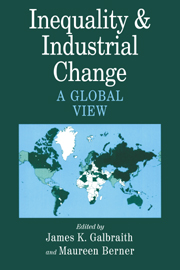Book contents
- Frontmatter
- Contents
- Contributors
- Permissions
- Acknowledgments
- PART I INTRODUCTION TO THEORY AND METHOD
- PART II INEQUALITY, UNEMPLOYMENT, AND INDUSTRIAL CHANGE
- PART III INEQUALITY AND DEVELOPMENT
- PART IV METHODS AND TECHNIQUES
- 15 Constructing Long, Dense Time Series of Inequality Using the Theil Index
- 16 Cluster and Discriminant Analysis of Time Series as a Research Tool
- Data Appendix
- References and Selected Bibliography
- Index
16 - Cluster and Discriminant Analysis of Time Series as a Research Tool
Published online by Cambridge University Press: 05 June 2012
- Frontmatter
- Contents
- Contributors
- Permissions
- Acknowledgments
- PART I INTRODUCTION TO THEORY AND METHOD
- PART II INEQUALITY, UNEMPLOYMENT, AND INDUSTRIAL CHANGE
- PART III INEQUALITY AND DEVELOPMENT
- PART IV METHODS AND TECHNIQUES
- 15 Constructing Long, Dense Time Series of Inequality Using the Theil Index
- 16 Cluster and Discriminant Analysis of Time Series as a Research Tool
- Data Appendix
- References and Selected Bibliography
- Index
Summary
This chapter presents a procedure for studying industrial performance and related issues, such as changes in the wage structure. This procedure combines cluster analysis and discriminant analysis as a package and applies this package to timeseries data. This enables us to organize industrial data into groups with similar wage or performance histories and then to extract summary time series showing the main pattern of variation in performance between groups.
Introduction
This chapter presents a procedure for studying industrial performance and related issues, such as change in the wage structure. The procedure combines cluster and discriminant analysis and applies them to time series data to explore, first, the group pattern and, second, the forces that promote the formation of that group pattern. This procedure can be applied to many fields for which time-series data are available on a single key measure of behavior for a large number of related entities – for example, wages by industry or occupation or expenditure by account in a study of government budgets.
The use of dated information as a tool for classification is well established in disciplines such as geology, paleontology, archeology, and even biology and developmental psychology. For example, Chiodi (1989) uses time-series height and arm span data to classify children, and Hirsch and DuBois (1991) classify children based on the similarities in behavior through time.
- Type
- Chapter
- Information
- Inequality and Industrial ChangeA Global View, pp. 280 - 286Publisher: Cambridge University PressPrint publication year: 2001
- 2
- Cited by



